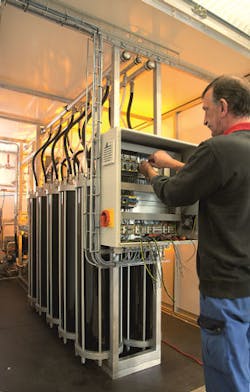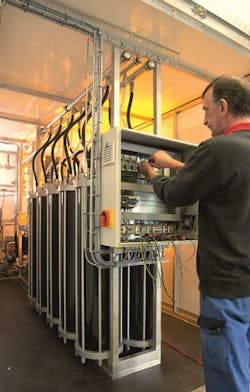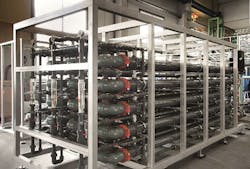The Rising Industrial Adoption of Zero Liquid Discharge
Zero-liquid discharge (ZLD) and similar solutions including minimised liquid discharge (MLD) are anticipated to play a more prominent future role in industrial water treatment across the globe. Ahead of the Industrial Water Solutions Forum in Singapore, this article looks at why a greater focus on environmental protection and water security is leading to a greater adoption of these technologies across multiple industries.
By Oliver Rappich
Booming megatrends in urbanisation and industrialisation are creating greater stress on the environment, including the world’s freshwater resources. In many areas globally - and particularly in fast-developing and emerging economies - rapid growth in manufacturing and industry presents a threat to water quality and puts tremendous strains on water supplies. Concerns related to water availability risks are heightened in regions prone to water scarcity.
As these trends escalate, industries that use vast amounts of water and generate significant quantities of wastewater are under mounting pressure to adopt more sustainable water management strategies that use less water, minimise impacts to receiving waters, and mitigate operational risks. This in turn is driving advancements that leverage technology in the global water treatment market.
ZLD and comparable approaches such as MLD are attracting greater interest as beneficial water treatment/water management solutions for difficult-to-treat industrial wastewaters.
Both strategies employ a sequence or “treatment train” of advanced treatment processes and technologies for maximising water recycling and minimising wastewater volumes. ZLD, however - by incorporating a final robust evaporation/crystallization stage - aims to completely eliminate all produced wastewater, reducing waste liabilities and decreasing discharge to the greatest extent allowable.
Drivers for adoption
In recent years, even as industrial economies continue to expand and produce greater volumes of contaminated wastewaters, more agreement is being reached internationally in terms of the necessity to safeguard the environment from pollution. This mindset represents a major shift from historical views and is helping to build more support for programs and policies that encourage best practices and innovative solutions for protecting ecosystems, conserving water supplies, and improving water quality.
Based on a rapid evolution in the acceptance of advanced technologies and increasing recognition of the value of sustainably-focused approaches, greater momentum is emerging worldwide across the industrial landscape for water treatment solutions such as ZLD and MLD that minimise waste, recover resources, treat toxic industrial waste streams more effectively, and mitigate potential water quality impacts to receiving waters.
Water intense processes
Industrial ZLD and MLD adoption is also being driven by rising global water stress and mounting risks to industries that depend on consistent water supplies. Water-shortage risks are especially severe for operators located in water-stressed areas and for industries with water-intensive processes such as food and beverage, power, and pulp and paper.
By “closing the loop” and enabling for treated water to be recycled and reused in process operations - or in other industrial applications that require water - ZLD and MLD offer a proven technical water management strategy for mitigating water-shortage risks by boosting water efficiency and reducing water intake requirements. For industrial operators in water-restricted areas, this benefit can help insulate industrial operators from escalating source water costs.
ZLD in particular, with the capacity to treat the most challenging wastewaters and virtually eliminate all discharge, is attracting rising interest as an effective and best available process for managing contaminated waste streams produced by industries such as power, chemical, steel, textile, electroplating and others as more regulatory focus is directed at the largest environmental polluters.
As an example, the U.S. Environmental Protection Agency (EPA) recently issued new Effluent Limit Guidelines (ELGs) for the steam electric power generating category, requiring ZLD for all pollutants associated with fly ash transport water, bottom ash transport water and flue gas mercury control (FGMC) wastewater in power plants that are 50 megawatts (MW) or higher.
ZLD in China
ZLD is also increasingly being mandated across a variety of industrial sectors in China and India as those countries look to better control polluted wastewater discharges to water resources and groundwater systems. In China, the government’s 12th Five-Year Plan - which includes objectives to enhance environmental protection - mandates the use of ZLD in new and existing coal-fired power plants and coal-to-chemical refining facilities for treating complex industrial process waste streams. ZLD requirements in India extend to a range of industrial sectors including power, steel, pharmaceutical, chemical, textile and food and beverage. As further industrial environmental standards are developed globally, ZLD is anticipated to factor in more prominently as governments continue to address heavy metals and other toxic contaminants in wastewater discharges.
Treatment trains
A wide array of treatment options can be used as part of ZLD and MLD approaches. In many respects, ZLD and MLD solutions should be viewed as an end-of-pipe result, with multiple strategies and combinations of technologies available to achieve those outcomes.
With respect to ZLD, treatment trains generally involve pre-treatment and pre-concentration steps, which can include solar ponds, reverse osmosis (RO), biological treatment, ion exchange, ultrafiltration, and other advanced technologies. This is prior to the final evaporation and crystallization stages that work to remove the remaining liquid wastes and minimize waste volumes. These robust end processes represent the key stages of a ZLD plant and typically accrue the highest allotment of capital costs.
In developing the most optimal sequence of ZLD treatment processes, numerous factors will come into play. Wastewaters generated from industrial operations can vary widely depending on the specific industry, process, or manufacturing function, and treatment strategies must consider pollutant loading concentrations, wastewater compositions, and whether or not certain contaminants - such as organics, heavy metals, salts, or acids - are present in the waste streams. Costs, discharge requirements, and source water characteristics are further dynamics that can shape and determine the best ZLD solution.
Cost barrier and solutions
Despite the many benefits of using ZLD solutions for treating and managing problematic industrial wastewaters, operators who adopt ZLD must still contend with a number of key challenges related to costs.
As with most advanced systems, the design and implementation of a ZLD plant requires a considerable capital investment. However, due to the substantially high energy requirements associated with ZLD treatment processes and especially the evaporation stage which is extremely energy intensive - operational expenses typically represent the largest cost expenditure for ZLD systems and often the most prohibitive factor for successful adoption. Ongoing chemical, maintenance, and solid disposal expenses represent further - and often significant cost-related considerations.
With the potential for the evaporation step to represent more than 90% of the total operating expenses of a ZLD solution, cost-efficiency advancements in ZLD systems should factor in the evaporation process for achieving the most improvement towards reducing ZLD operational costs.
Recent innovations in ZLD design employ a series of unique filtration and separation technologies to reduce residual waste products to a minimum, decreasing the subsequent evaporation needs. With waste volumes diminished, the evaporation stage is considerably shorter, enabling for lower energy requirements and decreased operating costs.
As issues with water scarcity continue to escalate and as governments take increasingly more action towards solving environmental problems and protecting water resources, the need for cutting-edge, optimised solutions will continue to increase.
ZLD and MLD will play a large role in meeting this demand, and with innovation and advancements actively emerging in ZLD/MLD technologies and processes, these solutions will only become more effective and viable.
Oliver Rappich is director of new markets and technologies of Hager + Elsässer. The topic of ZLD will be featured in the Industrial Water Solutions Forum, taking place on Wednesday 13th July as part of SIWW. The event will focus on the growing industrial water markets as well as wider discussions on oil & gas, petrochemical, food & beverage and power generation.


